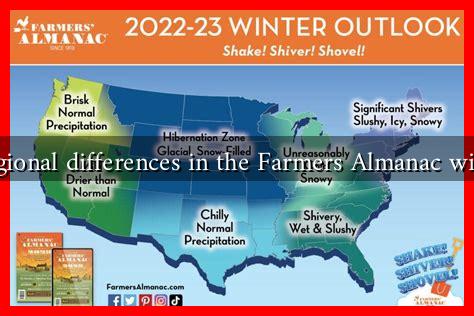-
Table of Contents
- Are There Regional Differences in the Farmers’ Almanac Winter Forecast?
- Understanding the Farmers’ Almanac Forecasting Methodology
- Regional Variations in Winter Forecasts
- Northeast Region
- Midwest Region
- Southern Region
- Western Region
- Case Studies: Historical Accuracy of Regional Forecasts
- Conclusion
Are There Regional Differences in the Farmers’ Almanac Winter Forecast?
The Farmers’ Almanac has been a trusted source for weather predictions since its inception in 1818. Known for its long-range forecasts, the Almanac provides insights into seasonal weather patterns across North America. However, one question that often arises is whether these forecasts vary significantly by region. This article delves into the regional differences in the Farmers’ Almanac winter forecast, exploring how geography, climate, and historical data influence predictions.
Understanding the Farmers’ Almanac Forecasting Methodology
The Farmers’ Almanac employs a unique blend of astronomical and meteorological data to create its forecasts. The methodology includes:
- Solar Activity: The Almanac considers solar cycles, which can influence weather patterns.
- Historical Weather Data: Past weather trends are analyzed to predict future conditions.
- Geographical Factors: Local geography, such as mountains and bodies of water, plays a crucial role in weather variations.
This multifaceted approach allows the Farmers’ Almanac to provide forecasts that can differ significantly from one region to another, reflecting the diverse climatic conditions across North America.
Regional Variations in Winter Forecasts
Winter forecasts from the Farmers’ Almanac are not one-size-fits-all.
. Here are some notable regional differences:
Northeast Region
The Northeast typically experiences cold, snowy winters. The Farmers’ Almanac often predicts:
- Above-average snowfall in states like New York and Pennsylvania.
- Cold snaps, particularly in January and February.
For example, the 2022-2023 winter forecast predicted a “cold and snowy” season for the Northeast, which aligned with historical patterns of heavy snowfall during La Niña years.
Midwest Region
The Midwest is known for its harsh winters, but the Farmers’ Almanac forecasts can vary significantly within this region:
- States like Minnesota and Wisconsin often see extreme cold and blizzards.
- In contrast, southern parts of the Midwest, such as Missouri, may experience milder conditions.
In the 2021-2022 winter forecast, the Almanac predicted a “polar coaster” effect, with fluctuating temperatures and significant snowfall in the northern Midwest.
Southern Region
The Southern United States generally enjoys milder winters, but the Farmers’ Almanac still provides specific forecasts:
- States like Texas and Florida may see cooler temperatures and occasional frost.
- Predictions for rain and storms are common, especially in the Gulf Coast region.
For instance, the 2020-2021 winter forecast indicated a wetter-than-average season for the Southeast, which was corroborated by increased precipitation data.
Western Region
The Western United States presents a mixed bag of weather patterns:
- The Pacific Northwest often experiences milder, wetter winters.
- The Rocky Mountains can expect heavy snowfall, particularly in ski areas.
The 2023 winter forecast suggested a “wet and wild” season for California, reflecting ongoing concerns about drought and water supply.
Case Studies: Historical Accuracy of Regional Forecasts
To assess the accuracy of the Farmers’ Almanac’s regional forecasts, we can look at historical data:
- In 2019, the Almanac predicted a “polar vortex” for the Midwest, which was validated by record low temperatures.
- In 2020, the Southeast experienced a colder winter than predicted, highlighting the challenges of forecasting in this region.
These case studies illustrate that while the Farmers’ Almanac provides valuable insights, regional variations can lead to discrepancies in accuracy.
Conclusion
In summary, the Farmers’ Almanac winter forecast does exhibit significant regional differences influenced by various factors, including geography, historical weather patterns, and solar activity. While the Almanac remains a popular resource for long-range weather predictions, it is essential for readers to consider these regional nuances when interpreting forecasts. Understanding these differences can help individuals and businesses better prepare for the winter months ahead.
For more detailed forecasts and insights, you can visit the official Farmers’ Almanac website.





